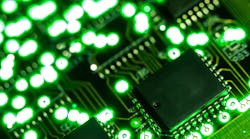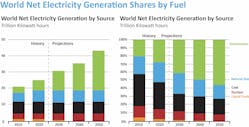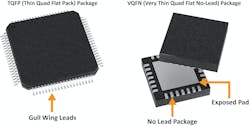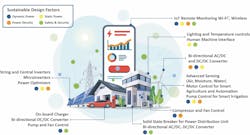What you’ll learn:
- The key attributes of semiconductors in designing for sustainability.
- The essential design factors for applications within a sustainable ecosystem.
Global sustainability is centered around environmental, economic, and social initiatives meant to protect and enhance the natural environment. These initiatives involve supporting a quality of life where basic human needs are met while utilizing technologies having positive environmental impacts.
One of the most visible phenomena that sustainability initiatives strive to mitigate is the effects of climate change. “Climate change is widely seen as the biggest challenge of our age. Vast financial and human resources are being mobilized to deal with the causes and effects of climate change, and to bring about an energy transition away from fossil fuels to renewable resources” (Prysmian Group, 2023).
Growth in the human population, the rise in e-mobility, requirements of industrial automation, enhanced computing requirements for hyperscale data processing, and the proliferation of smart, battery-powered IoT devices is increasing demand for electricity generation. If fossil fuels are the only energy source used to meet this rise in demand, the resultant higher volume of greenhouse gas emissions would exacerbate the already visible effects of climate change.
Therefore, it’s imperative that renewable-energy sources generate a larger share of the increased demand for electricity vs. fossil fuels. According to Figure 1, between 2020 and 2050, world net electricity generation is expected to increase from 25 trillion kWh to approximately 40 trillion kWh. The share of electricity from renewable-energy sources, the majority being wind and solar, will ramp up from approximately 30% to 65% in the same timeframe.
The efficacy of a renewable power source is predicated on maximizing the power transfer from the source to either the power grid or electrical loads. These electrical loads can be frequently used consumer devices, household appliances or large-scale battery energy storage systems (ESS).
Furthermore, the electrical loads themselves must consume a minimal amount of power during operation to foster efficient energy usage created by both renewable and non-renewable sources. To meet these objectives, it’s imperative that the integrated circuits (ICs) and application-specific integrated circuits (ASICs) constituting renewable power conversion and embedded systems exhibit low power dissipation, high reliability, high power density, and security (Fig. 2).
Design for Low Power
A highly coveted attribute of semiconductors in sustainable designs is low power consumption. For battery-powered smart devices characteristic of sustainable ecosystems, low power consumption extends the battery life, which translates into longer operating times between recharges thereby conserving energy.
For high-power DC-DC and AC-DC conversion systems in renewable-energy applications, lower power consumption translates into higher system efficiencies that exhibit more parity between the power generated and supplied to an electronic load.
The two primary sources of semiconductor power losses in an embedded control system are static and dynamic power dissipation. Static power is characterized as power consumption when a circuit is in a “standby” or non-operational state, commonly termed “leakage.” Dynamic power dissipation is characterized as power consumption when the circuit is in an operational state.
In general, the lower the process technology node and reduction in device geometry, the higher the “leakage” or static power dissipation and the lower the dynamic power dissipation due to the smaller device capacitances. In turn, larger semiconductor geometries exhibit the opposite trend.
These tradeoffs must be considered when designing the semiconductor for specific applications. This depends on if the system is battery powered, where static power dissipation must be minimized, or a renewable power-conversion system where it's prudent to limit dynamic power dissipation.
To curb both dynamic and static power dissipation, semiconductors are designed to minimize capacitance through design of their internal layout, operate at lower voltage levels, and be flexible to activate and disable their respective functional blocks if the device is in “deep sleep” standby or functional mode.
Reliability in Device Packaging
Performance in sustainable systems can be measured through part reliability and system longevity. Both may be compromised by the operation of a semiconductor device operating at the higher ends of their temperature ratings. Depending on the application environment, semiconductor packages can also be susceptible to mechanical stresses and torsion where board-level reliability is essential for system survival.
Microchip Technology, along with many other semiconductor manufacturers, use the VQFN and TQFP packages to encapsulate complex integrated circuits, such as digital signal controllers, in small-form-factor packages (Fig. 3).
The VQFN package uses exposed pads on the bottom surface of the package to effectively dissipate an adequate amount of heat. This helps maintain a low enough junction to ambient thermal resistance (°C/W) when the device is operating at its maximum capacity.
TQFP packages use gull-wing type of leads on a low-profile height package to withstand vibrational forces and other mechanical stresses in harsh operating environments to establish high board level reliability. In addition, low-profile packages enable sustainable system designers to use smaller volume enclosures that not only reduce system cost, but also use less material. This leads to a smaller volume of waste at the end of a product’s usable lifecycle.
High Power with System Miniaturization
Semiconductors that exhibit high power densities are rated to run at high power levels while being encompassed in small footprints. These are the typical attributes of silicon-carbide (SiC) and gallium-nitride (GaN) wide-bandgap discretes and power modules used in solar, wind, and electric-vehicle power-conversion applications.
SiC and GaN make it possible to miniaturize power-conversion systems by allowing system operation at higher frequencies. The higher-frequency operation enables a reduction in the size and weight of the electrical passives needed to transfer the maximum amount of power generated by a renewable source, as well as maintain high power-conversion system efficiency.
Security Equals Longevity
Security features of semiconductors are essential for sustainable system development. Security features in microcontrollers, like secure and immutable boot, can enable continued reuse of an existing system. Such features verify the integrity of any software updates necessary to enhance system performance or implement bug fixes in the code. As a result, a design could be used for longer time periods without undergoing replacement and later scrapped due to obsolescence.
Secure key storage and node authentication are security features implemented in semiconductor devices that protect against external attacks and ensure that only genuine code executes on an embedded design. These features allow two or more integrated circuits to acknowledge the receipt and transmission of cryptographic data between “trusted” sources without compromising system performance.
Sustainability in the Energy Ecosystem
Sustainable designs are part of an ecosystem of energy producers and consumers with the challenges of not only generating and storing the largest amount of power from a renewable source, but also using efficient control systems to use this energy. The semiconductors developed for producer and consumer systems consider sustainable design factors.
Many semiconductor vendors, such as Microchip Technology, innovate products with lower power-consumption modes, increased power densities, and advanced features for security and safety to meet the market demands for the design factors needed in sustainable systems like those demonstrated in Figure 4. Some of these applications range from simple, yet highly efficient pumps and fans to complex green-energy generation and storage.
References
What are the biggest sustainability threats?, Prysmian Group (n.d.). https://www.prysmiangroup.com/en/insight/sustainability/what-are-the-biggest-sustainability-threats
2022 Sustainability Report, Microchip (n.d.).
Ivey, Brant. (2011). Low-Power Design Guide (Application note: 1416). Retrieved from Microchip Technology Corporation Website.
Microchip Packaging Specification, 2015 (n.d.).




